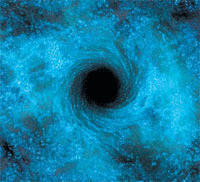Astronomers, for the first time, have measured the spin rate of a super-massive black hole - and found it is rotating at nearly the speed of light.
The supermassive black hole lies at the center of the spiral galaxy NGC 1365. The sphere is more than 2 million miles across – eight times the distance from Earth to the Moon.
Astronomers measured its jaw-dropping spin rate using new data from the Nuclear Spectroscopic Telescope Array, or NuSTAR, and the European Space Agency's XMM-Newton X-ray satellites.
"This is the first time anyone has accurately measured the spin of a supermassive black hole," said lead author Guido Risaliti of the Harvard-Smithsonian Center for Astrophysics (CfA) and INAF – Arcetri Observatory.
This research is being published in the journal Nature.
A black hole's gravity is so strong that, as the black hole spins, it drags the surrounding space along. The edge of this spinning hole is called the event horizon.
Any material crossing the event horizon is pulled into the black hole. Inspiraling matter collects into an accretion disk, where friction heats it and causes it to emit X-rays.
Risaliti and his colleagues measured X-rays from the center of NGC 1365 to determine where the inner edge of the accretion disk was located.
This Innermost Stable Circular Orbit - the disk's point of no return - depends on the black hole's spin. Since a spinning black hole distorts space, the disk material can get closer to the black hole before being sucked in.
Astronomers want to know the black hole's spin for several reasons. The first is physical – only two numbers define a black hole: mass and spin. By learning those two numbers, you learn everything there is to know about the black hole.
Most importantly, the black hole's spin gives clues to its past and by extension the evolution of its host galaxy.
"The black hole's spin is a memory, a record, of the past history of the galaxy as a whole," Risaliti said in a statement.
Although the black hole in NGC 1365 is currently as massive as several million Suns, it was not born that big. It grew over billions of years by accreting stars and gas, and by merging with other black holes.
aying on a children's swing. If you kick at random times while you swing, you will never get very high. But if you kick at the beginning of each downswing, you go higher and higher as you add angular momentum.
Studying a supermassive black hole also allows theorists to test Einstein's theory of general relativity in extreme conditions.
